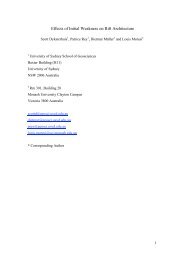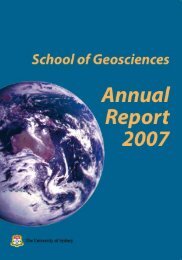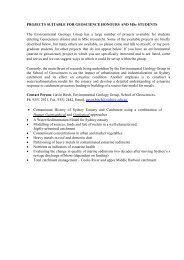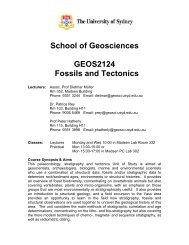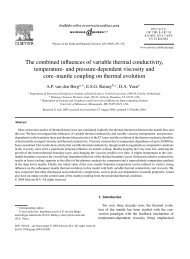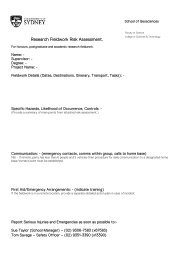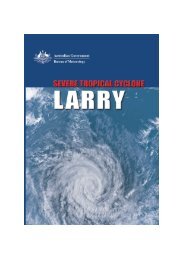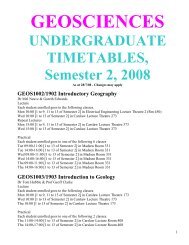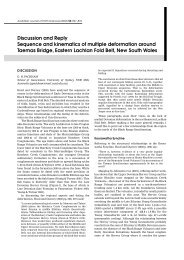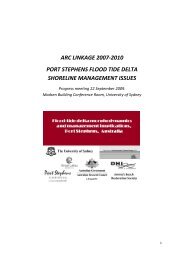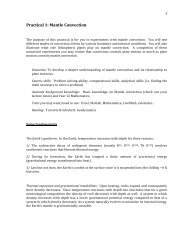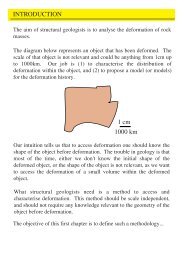Geological and historical records of tsunami in Australia
Geological and historical records of tsunami in Australia
Geological and historical records of tsunami in Australia
Create successful ePaper yourself
Turn your PDF publications into a flip-book with our unique Google optimized e-Paper software.
108 D. Dom<strong>in</strong>ey-Howes / Mar<strong>in</strong>e Geology 239 (2007) 99–123<br />
sediment slides <strong>of</strong> the volume <strong>and</strong> type <strong>of</strong> Lanai<br />
certa<strong>in</strong>ly have the capacity to generate <strong>tsunami</strong>, the<br />
on-shore evidence for the 105 ka <strong>tsunami</strong> on Lanai<br />
itself, has now been challenged call<strong>in</strong>g <strong>in</strong> to question the<br />
occurrence <strong>of</strong> the reported 105 ka Lanai <strong>tsunami</strong> (Felton<br />
et al., 2000; Keat<strong>in</strong>g <strong>and</strong> Helsley, 2002; Felton et al.,<br />
2006). Consequently, the claim <strong>of</strong> Young et al (ibid) for<br />
a ‘cause <strong>and</strong> effect relationship’ between their field<br />
evidence on the NSW coast <strong>and</strong> the proposed Lanai<br />
slide <strong>tsunami</strong> should probably now be re-exam<strong>in</strong>ed. In<br />
light <strong>of</strong> the work <strong>of</strong> Felton et al., (2000); Keat<strong>in</strong>g <strong>and</strong><br />
Helsley (2002); Felton et al., (2006), <strong>tsunami</strong> event ID<br />
number 4 has been given a ‘validity score’ <strong>of</strong> just 2<br />
(<strong>in</strong>dicat<strong>in</strong>g that this event is <strong>in</strong> fact, doubtful).<br />
The reported Holocene palaeo<strong>tsunami</strong> record <strong>of</strong><br />
<strong>Australia</strong> (<strong>and</strong> NSW <strong>in</strong> particular) is tantalis<strong>in</strong>g.<br />
Independent validation <strong>of</strong> the reported record has<br />
pr<strong>of</strong>ound implications for underst<strong>and</strong><strong>in</strong>g <strong>Australia</strong>n<br />
coastal evolutionary processes <strong>and</strong> for determ<strong>in</strong><strong>in</strong>g<br />
coastal vulnerability <strong>in</strong> the region. This is because the<br />
reported palaeo<strong>tsunami</strong> evidence generally po<strong>in</strong>ts<br />
towards the occurrence <strong>of</strong> high-magnitude (low-frequency)<br />
events — potentially orders <strong>of</strong> magnitude<br />
larger than anyth<strong>in</strong>g observed dur<strong>in</strong>g historic times.<br />
Furthermore, the locations <strong>of</strong> these reported highmagnitude<br />
palaeo<strong>tsunami</strong> deposits co<strong>in</strong>cides with the<br />
very high exposure <strong>of</strong> people <strong>and</strong> <strong>in</strong>frastructure along<br />
the Newcastle–Sydney–Wollongong coastal corridor.<br />
For example, <strong>tsunami</strong> event ID number 5 is reported to<br />
have generated a run-up <strong>in</strong> excess <strong>of</strong> +100 m asl <strong>and</strong><br />
<strong>tsunami</strong> event ID number 6 may have <strong>in</strong>undated the<br />
coast to distances <strong>of</strong> 10 km <strong>in</strong>l<strong>and</strong>. If the field evidence<br />
for these events is accepted, it should be a matter <strong>of</strong><br />
urgency to determ<strong>in</strong>e how frequently events <strong>of</strong> this<br />
magnitude occur <strong>and</strong> from where they orig<strong>in</strong>ate.<br />
However, some authors have begun to question the<br />
evidence reported for <strong>Australia</strong>n palaeo<strong>tsunami</strong> (Felton<br />
<strong>and</strong> Crook, 2003; G<strong>of</strong>f <strong>and</strong> McFadgen, 2003; G<strong>of</strong>f et al.,<br />
2003; Noormets et al., 2004; Dom<strong>in</strong>ey-Howes et al.,<br />
2006). The controversy surround<strong>in</strong>g the reported<br />
palaeo<strong>tsunami</strong> record will be discussed <strong>in</strong> Section 4.4.<br />
4.3. Discussion <strong>of</strong> the historic <strong>tsunami</strong> record identified<br />
<strong>in</strong> the prelim<strong>in</strong>ary catalogue<br />
S<strong>in</strong>ce AD1858 (the date <strong>of</strong> the first event recorded<br />
dur<strong>in</strong>g the historic period), 47 <strong>tsunami</strong> have affected<br />
<strong>Australia</strong>. Given the previously noted view that<br />
<strong>Australia</strong> is a place <strong>of</strong> low <strong>tsunami</strong> risk, this record <strong>of</strong><br />
events might be considered rather frequent. The historic<br />
record is biased towards events recorded dur<strong>in</strong>g the 20th<br />
<strong>and</strong> 21st centuries <strong>and</strong> also to those recorded on the New<br />
South Wales coast. Aga<strong>in</strong>, this should not be considered<br />
a surprise given the high density occupation <strong>of</strong> the<br />
eastern seaboard, the location <strong>of</strong> major ports <strong>and</strong><br />
research <strong>in</strong>stitutes <strong>and</strong> mar<strong>in</strong>e organisations.<br />
It is possible that for the historic period, the actual<br />
number <strong>of</strong> <strong>tsunami</strong> that impacted the <strong>Australia</strong>n coasts is<br />
likely to be much higher than that recorded. <strong>Australia</strong><br />
has a very long convoluted coastl<strong>in</strong>e (that extends for<br />
more than 60,000 km) (Harvey <strong>and</strong> Caton, 2003) —<br />
90% <strong>of</strong> which is not occupied or visited regularly.<br />
Therefore, there is a high probability that many events<br />
have gone unrecorded, particularly on the north eastern,<br />
northern <strong>and</strong> north western coasts close to tectonically<br />
active areas such as Papua New Gu<strong>in</strong>ea, the Solomon<br />
Isl<strong>and</strong>s <strong>and</strong> the Indonesian archipelago. Similar observations<br />
were made by Scheffers <strong>and</strong> Kelletat (2003).<br />
The maximum run-up for a historic event <strong>of</strong> +6 m asl<br />
(<strong>tsunami</strong> event ID number 48) is <strong>in</strong>terest<strong>in</strong>g. Whilst the<br />
largest recorded run-up for a historic event (although<br />
surveys <strong>of</strong> the July 2006 event may <strong>in</strong>dicate larger runups<br />
(Prendergast., pers. comm.)), it is dwarfed by the<br />
maximum palaeo run-up. If the historic record is relied<br />
upon to determ<strong>in</strong>e risk, it would suggest that the NW<br />
coastal region <strong>of</strong> <strong>Australia</strong> represents the highest hazard<br />
with<strong>in</strong> <strong>Australia</strong>. However, exposure is relatively low <strong>in</strong><br />
this region. This trend is the reverse <strong>of</strong> that <strong>in</strong>dicated by<br />
the palaeo record.<br />
Us<strong>in</strong>g the <strong>tsunami</strong>genic zones <strong>of</strong> the Pacific region<br />
identified by Gusiakov (2005), it is possible to exam<strong>in</strong>e<br />
from where <strong>tsunami</strong> affect<strong>in</strong>g <strong>Australia</strong> orig<strong>in</strong>ate (at<br />
least for the historic period). By far the largest<br />
percentage <strong>of</strong> <strong>tsunami</strong> affect<strong>in</strong>g <strong>Australia</strong> (25.5%)<br />
s<strong>in</strong>ce AD1858 orig<strong>in</strong>ated <strong>in</strong> the Papua New Gu<strong>in</strong>ea,<br />
Solomon Isl<strong>and</strong>s <strong>and</strong> Indonesia region <strong>and</strong> as such, may<br />
represent an important future source region. However,<br />
caution should be exercised given the limited number <strong>of</strong><br />
events actually identified <strong>in</strong> the catalogue. The next<br />
most important source region is South America —<br />
responsible for 12.8% <strong>of</strong> <strong>Australia</strong>n <strong>tsunami</strong>. Thirtyeight<br />
percent <strong>of</strong> <strong>tsunami</strong> were generated <strong>in</strong> regions<br />
across the Pacific <strong>and</strong> Southern Oceans <strong>and</strong> significantly,<br />
23.4% <strong>of</strong> historic <strong>tsunami</strong> were generated <strong>in</strong><br />
unknown source regions. Given the relatively high<br />
percentage <strong>of</strong> <strong>Australia</strong>n <strong>tsunami</strong> orig<strong>in</strong>at<strong>in</strong>g <strong>in</strong><br />
unknown source areas, scientists <strong>and</strong> authorities should<br />
tread carefully when th<strong>in</strong>k<strong>in</strong>g about risk.<br />
There are several important issues that arise from an<br />
analysis <strong>of</strong> the recent <strong>tsunami</strong> history <strong>of</strong> <strong>Australia</strong>.<br />
4.3.1. Coverage <strong>and</strong> extent <strong>of</strong> reports<br />
There is a remarkable bias <strong>in</strong> the catalogue towards<br />
those events recorded on the eastern sea board as already



